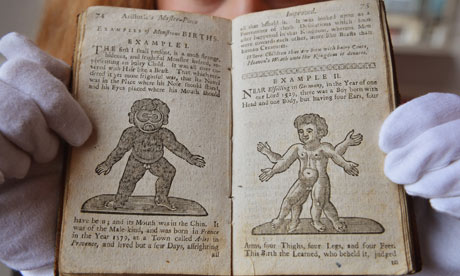 An edition of Aristotle's Compleat Master-Piece from the 1760s is to be auctioned at Lyon & Turnbull in Edinburgh. Photograph: Jeff J Mitchell/Getty Images
An edition of Aristotle's Compleat Master-Piece from the 1760s is to be auctioned at Lyon & Turnbull in Edinburgh. Photograph: Jeff J Mitchell/Getty Images An early manual on sex and pregnancy, which was banned from sale in the UK for more than 200 years will go under the hammer this month.
Aristotle's Compleat Master-Piece first appeared around 1680. It sets out ideas on sexual relationships and how to conceive. It was banned in the mid-18th century and remained a forbidden text until the prohibition was lifted in the 1960s.
An edition printed in the 1760s is expected to fetch up to £400 when it goes on sale at Edinburgh auction house Lyon and Turnbull.
Cathy Marsden, a book specialist at the auctioneers, said: "It was very popular. It was probably the most printed text of its kind and it went through a lot of editions. It's fascinating reading. It tells an amazing story about the changing perspectives on sex."
The book is thought to have served as a reference guide for amateur midwives and young married couples. It includes dire warnings about the possible consequences of extramarital sex.
"There's nothing in it that would really be considered dirty in our society now. It's funny more than anything," Marsden said. "There are various things which warn parents about what could happen to their children if they sinned whilst conceiving them, perhaps by having sex outside marriage. It would say that your baby would be born all hairy or it would suggest that conjoined twins were the result of the parents' sins.
"There are also interesting bits about the 17th century notion that it was considered beneficial for a woman to enjoy sexual intercourse in order to conceive. It suggests that both men and women should enjoy sex.
"That's interesting because much later on, when they realised that a woman didn't have to climax in order to conceive, the idea of a woman enjoying sex was considered far less important."
The book was attributed to Aristotle but there is little, if any, of his work in the text. Nothing is known of the actual author of the piece.
Marsden said: "We don't really know why it was attributed to Aristotle but one possibility is that they were just trying to make it sound better or more worthy than it might have been."
She added that the book ban probably occurred around the middle of the 18th century, a time when various legal cases saw several books deemed too rude to be allowed for sale.
It remained banned in the UK until 1961, although it could be legally obtained in countries such as New Zealand throughout the Victorian era.
Marsden said the pictures in the book are thought to be one of the main reasons it became a forbidden text. "To our eyes they're not graphic at all," she said. "There's one image of a baby in a womb and the woman's torso has been 'cut open' to show the baby.
"There are other images of hairy children or children with their mouths where their navels are. They are very strange images."
But the banned book continued to thrive in a vibrant black market.
"It was very popular whilst it was banned. You could certainly buy it under the counter," said Marsden.
Simon Vickers, also a book specialist at Lyon and Turnbull, said: "Drawing from the works of Nicholas Culpeper and Albertus Magnus, with a good dose of old wives' tale, there were more editions of this work published in the 18th century than any other medical text. However, Aristotle's Compleat Master-Piece slowly began to be considered highly distasteful and even downright lewd and was banned in Britain until 1961."
A cutting from 1930s newspaper advice column is said to have included a question from a reader asking where a copy of the book could be obtained.
Apparently contradicting itself, the reply stated: "You may not buy a copy of Aristotle's Complete Master-Piece. You may expect to pay three-and-sixpence."
The edition being auctioned at Lyon & Turnbull is thought to have been published around 1766. It will go under the hammer in Edinburgh on 16 January.
Source: The Guardian, Thursday 3 January 2013 http://www.guardian.co.uk/books/2013/jan/03/victorian-manual-under-the-hammer?CMP=twt_fd